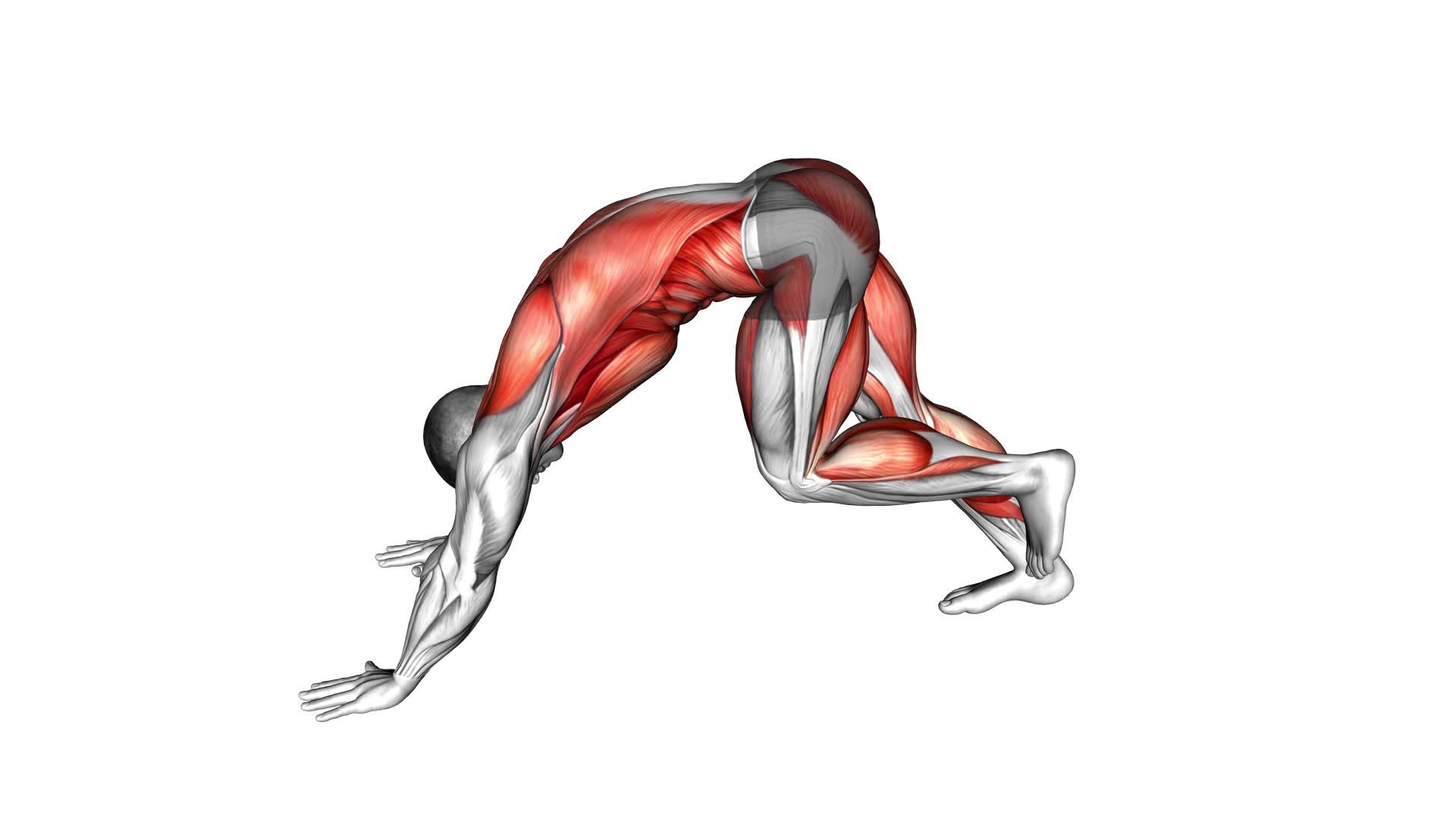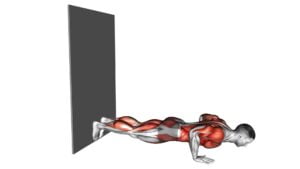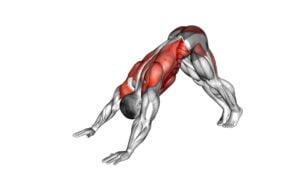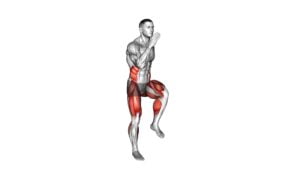Downward Dog Sprint (Male) – Video Exercise Guide & Tips

Are you looking for a challenging and effective exercise to add to your workout routine? Look no further than the Downward Dog Sprint.
Watch This Exercise Video
This video exercise guide and tips will provide you with all the information you need to perform this exercise correctly and safely.
Whether you're a beginner or a seasoned fitness enthusiast, this exercise can be modified to suit your fitness level.
Get ready to strengthen your muscles and improve your overall fitness with the Downward Dog Sprint.
Key Takeaways
- The Downward Dog Sprint is a beneficial exercise that improves flexibility, strengthens the upper body, tones the arms and core, and stretches the hamstrings and calves.
- Proper form and technique for the Downward Dog Sprint include maintaining a straight line from hands to feet, engaging the muscles in the arms, shoulders, core, glutes, and legs, and starting in a high plank position before pressing the hips up and back into an inverted V shape.
- There are variations and modifications for all fitness levels, such as performing the exercise with knees on the ground for beginners, decreasing the range of motion for limited mobility, or adding a push-up for advanced challenge.
- Common mistakes to avoid during the Downward Dog Sprint include rounding the back, neglecting lower body engagement, dropping the head and rounding the shoulders, and placing too much weight on the wrists.
Benefits of the Downward Dog Sprint
Improve your flexibility and strengthen your upper body by incorporating the Downward Dog Sprint into your workout routine. This exercise offers a wide range of physical and mental benefits, making it an excellent addition to any fitness regimen.
Physically, the Downward Dog Sprint engages and tones the muscles in your arms, shoulders, and core. It also stretches and lengthens the muscles in your hamstrings and calves, promoting increased flexibility. Additionally, this exercise helps improve posture and balance, as it requires you to align your body in a straight line from your hands to your feet.
Mentally, the Downward Dog Sprint can be a great way to relieve stress and calm the mind. As you hold the pose, focus on your breath and try to let go of any tension or worries. The combination of physical movement and mindful breathing can help clear your mind and promote a sense of relaxation and well-being.
Furthermore, the Downward Dog Sprint can be modified to suit your fitness level and goals. You can adjust the intensity by holding the pose for longer periods or incorporating variations such as leg lifts or knee taps. These modifications allow you to continually challenge yourself and progress in your fitness journey.
Now that you understand the physical and mental benefits, let's move on to the next section and learn about the proper form and technique for the Downward Dog Sprint.
Proper Form and Technique
To ensure proper execution of the Downward Dog Sprint, it's important to focus on maintaining a straight line from your hands to your feet, as discussed in the previous subtopic. This alignment is crucial for engaging the correct muscle groups and maximizing the benefits of this exercise.
One of the most common misconceptions about the Downward Dog Sprint is that it primarily targets the arms and shoulders. While these muscle groups are indeed engaged, this exercise actually works the entire body, including the core, glutes, and legs. By maintaining a straight line from your hands to your feet, you activate the muscles in your arms and shoulders to support your body weight. At the same time, your core muscles work to stabilize your torso, while your glutes and legs provide the power for the sprinting motion.
To maintain proper form and technique during the Downward Dog Sprint, start in a high plank position with your hands directly under your shoulders. Press your hips up and back, bringing your body into an inverted V shape. Keep your heels pressing towards the ground and actively engage your core by drawing your navel towards your spine. As you sprint, focus on driving your knees towards your chest, maintaining the straight line from your hands to your feet.
Variations and Modifications for All Fitness Levels
For all fitness levels, there are various ways to modify and adapt the Downward Dog Sprint exercise. If you're just starting out or have limited mobility, there are beginner modifications that can help you ease into the movement. One option is to perform the exercise with your knees on the ground. This reduces the demand on your arms and shoulders, making it more accessible for beginners. Another modification is to decrease the range of motion by only lifting your hips slightly off the ground and focusing on maintaining a strong core.
On the other hand, if you're looking for a challenge or want to take the exercise to the next level, there are advanced variations that can push your limits. One advanced variation is to add a push-up at the bottom of the movement. As you come down from the downward dog position, lower your chest towards the ground and then push back up before sprinting forward. This adds an extra upper body and core challenge to the exercise.
By modifying or advancing the Downward Dog Sprint exercise, you can tailor it to your fitness level and goals.
Now, let's move on to the next section and discuss common mistakes to avoid, so you can perform this exercise safely and effectively.
Common Mistakes to Avoid
Make sure to avoid these common mistakes when performing the Downward Dog Sprint exercise. To ensure that you're getting the most out of this dynamic movement, it's important to focus on proper technique. Here are three common mistakes to watch out for:
- Rounding your back: One of the most common errors is allowing your back to round during the downward dog position. This not only puts unnecessary strain on your spine but also takes away from the effectiveness of the exercise. Keep your spine neutral and engage your core to maintain proper alignment.
- Forgetting to breathe: Breathing is essential during any exercise, and the downward dog sprint is no exception. Many people tend to hold their breath, which can lead to dizziness and reduced performance. Remember to inhale deeply as you transition into the sprint and exhale forcefully as you push off the ground.
- Neglecting your lower body: The downward dog sprint is a full-body exercise that targets your upper body, core, and lower body. However, it's common for people to focus solely on their upper body and neglect their lower body. Remember to engage your glutes, quads, and hamstrings throughout the movement to maximize the benefits.
Tips for Incorporating the Downward Dog Sprint Into Your Workout Routine
To maximize your results, incorporate the Downward Dog Sprint into your workout routine by focusing on proper form and engaging all major muscle groups. This exercise not only helps in strengthening your upper body, but also works your core, legs, and glutes.
To prevent injury and make the most of your time-saving workouts, follow these tips:
- Warm up: Before starting any exercise, it's important to warm up your body. Perform some dynamic stretches to loosen up your muscles and increase blood flow.
- Proper alignment: Make sure to maintain a straight line from your hands to your hips and from your hips to your heels. This will help prevent strain on your back and shoulders.
- Engage your core: Throughout the exercise, focus on tightening your abdominal muscles. This won't only help in stabilizing your body, but also enhance the effectiveness of the exercise.
- Breathe: Remember to breathe deeply and rhythmically as you perform the downward dog sprint. Inhale as you push back into the downward dog position and exhale as you sprint forward.
- Take it slow: Start with a slow and controlled movement to ensure proper form. As you become more comfortable, you can increase the speed and intensity.
By incorporating the Downward Dog Sprint into your workout routine with these tips in mind, you won't only prevent injury, but also save time and achieve maximum results.
Stay consistent and challenge yourself to reach new limits. Your body will thank you for it.
Frequently Asked Questions
How Many Calories Can I Burn by Doing the Downward Dog Sprint?
When it comes to burning calories, the Downward Dog Sprint can be a great exercise option. This variation of the downward dog pose combines the benefits of yoga for weight loss with the intensity of a sprint.
By engaging your core, arms, and legs, this exercise can help you burn a significant amount of calories. So, if you're looking for an effective way to shed some pounds, give the Downward Dog Sprint a try.
You won't be disappointed.
Can the Downward Dog Sprint Help Improve My Flexibility?
Improving flexibility is essential for overall fitness and preventing injuries. The downward dog sprint is a great exercise that can help you achieve this goal.
By engaging your muscles and stretching them in this position, you can gradually increase your flexibility over time.
The benefits of the downward dog sprint include strengthening your core, improving balance, and toning your muscles.
Is It Safe to Perform the Downward Dog Sprint if I Have a History of Lower Back Pain?
Yes, it's safe to perform the downward dog sprint if you have a history of lower back pain. However, it's important to modify the pose to suit your needs.
By practicing downward dog with the correct modifications, you can actually benefit from improved flexibility and relief from back pain.
Remember to listen to your body and consult with a professional if needed.
Don't let your past hold you back – embrace the benefits of downward dog!
Can the Downward Dog Sprint Be Beneficial for Runners or Athletes?
The downward dog sprint can be incredibly beneficial for runners and athletes. By incorporating downward dog variations into your routine, you can improve your overall flexibility, strength, and balance.
Yoga, in general, offers numerous benefits for athletes, such as increased body awareness and enhanced recovery. It can also help prevent injuries and improve performance.
How Often Should I Include the Downward Dog Sprint in My Workout Routine to See Results?
To see results from the downward dog sprint, you should include it in your workout routine regularly. The frequency depends on your workout intensity and goals. Aim to incorporate this exercise at least 2-3 times a week, allowing for rest and recovery in between.
Additionally, try incorporating variations of the downward dog sprint, such as adding in leg lifts or incorporating it into a circuit workout, to keep challenging your body and continue seeing progress.
Stay consistent and motivated to achieve your fitness goals.
Conclusion
Incorporating the Downward Dog Sprint into your workout routine can provide numerous benefits for your body and mind. By maintaining proper form and technique, you can strengthen your core, improve flexibility, and increase overall fitness levels.
With variations and modifications available for all fitness levels, this exercise can be tailored to meet your specific needs. Avoid common mistakes and follow the tips provided to maximize the effectiveness of the Downward Dog Sprint.
Get ready to enhance your workout experience and achieve your fitness goals!

Author
Years ago, the spark of my life’s passion ignited in my mind the moment I stepped into the local gym for the first time. The inaugural bead of perspiration, the initial endeavor, the very first surge of endorphins, and a sense of pride that washed over me post-workout marked the beginning of my deep-seated interest in strength sports, fitness, and sports nutrition. This very curiosity blossomed rapidly into a profound fascination, propelling me to earn a Master’s degree in Physical Education from the Academy of Physical Education in Krakow, followed by a Sports Manager diploma from the Jagiellonian University. My journey of growth led me to gain more specialized qualifications, such as being a certified personal trainer with a focus on sports dietetics, a lifeguard, and an instructor for wellness and corrective gymnastics. Theoretical knowledge paired seamlessly with practical experience, reinforcing my belief that the transformation of individuals under my guidance was also a reflection of my personal growth. This belief holds true even today. Each day, I strive to push the boundaries and explore new realms. These realms gently elevate me to greater heights. The unique combination of passion for my field and the continuous quest for growth fuels my drive to break new ground.







